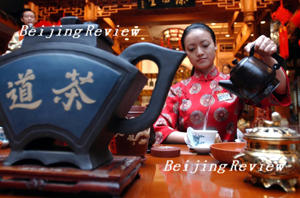
China’s teahouses were first called chafang or chasi. Tracing back in historical records, as early as the third century, old ladies would bring pots of fresh tea to downtown markets to sell. Until the seventh century, there emerged teahouses in towns and cities, and in the 10th century, the drinking of tea prevailed with teahouses scattered along streets. Later in the 17th century, the teahouse business became rife and the variety was enormous. Take Beijing for example. Teahouses are endowed with rich meanings such as dachaguan (teahouse where tea and snacks are served), qingchaguan, shuchaguan (teahouse where storytelling is performed), xichaguan (teahouse where opera is performed), qichaguan (teahouse where chess is played) and yechaguan (teahouse located in suburbs).
Handed down throughout the history of Beijing was dachaguan, which served as much more than mere teahouses. Visitors could drink various teas and sit among the many business people and intellectuals who frequented these houses. When social unrest or some form of disaster took place, teahouses were used as places to get and exchange information. The social function they served was really vital for a society that needed to communicate. Tianhuixuan Teahouse at Di’anmenwai and Huifengxuan Teahouse at Donganmenwai were the two most famous old Beijing dachaguan.
The scene was dramatically different in old-style shuchaguan, where audiences could enjoy storytelling by folk artists, while sipping their favorite brew. The usual programs were well-known Chinese ancient novels such as The Romance of the Three Kingdoms and Pilgrimage to the West. In old Beijing, such shuchaguan were congested in the eastern part of the city, like Donghuamen’s Dongyuexuan or Di’anmen’s Tonghexuan.
An older clientele gave the qingchaguan a bygone feel, no matter what generation it was. These houses, with their simple décor and neat interiors, were for drinking tea served in covered bowls. In the late Qing Dynasty (1616-1911, the last feudal authorities in China’s history), aristocrats of the royal family were frequent visitors to qingchaguan. Today, most Beijing teahouses are in this category. After retirees are done with their morning exercises, they make a beeline to these establishments, hanging birdcages outside, and settling down to a refreshing pot of tea and chat.
Yechaguan set in suburbs of old Beijing also originated in the Qing Dynasty. Since imperial gardens were for the privilege of lords, common civilians began to head out of the city on short excursions, giving rise to the yechaguan boom. Usually located in places with beautiful scenery, such teahouses gave visitors a chance to sip tea and get back to nature.
Along with these, qichaguan and xichaguan also left their own marks in history through their own unique characteristics.
|
